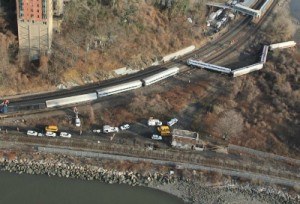The revelation that a New York City commuter train derailed while barreling into a sharp curve at nearly three times the speed limit is fueling questions about whether automated crash-avoidance technology could have prevented the carnage.
Safety officials for decades have championed what’s known as positive train control technology, which uses GPS, wireless radio and computers to monitor trains and stop them from colliding, derailing or going the wrong way. But the railroad industry has sought to postpone having to install the systems because of the high cost and technological issues.

Investigators haven’t yet determined whether the weekend wreck, which killed four people and injured more than 60 others, was the result of human error or mechanical trouble. But some safety experts said the tragedy might not have happened if Metro-North Railroad had the technology.
The train was going 82 mph (132 kph) as it entered a 30 mph (48 kph) turn Sunday morning and ran off the track, National Transportation Safety Board member Earl Weener said Monday. He cited information extracted from the train’s two data recorders; investigators also began interviewing the train’s crew.
New York Gov. Andrew Cuomo said authorities must “make sure that that operator is disciplined in an appropriate way.”
“There’s such a gross deviation from the norm,” Cuomo said. “That amount of speed is certainly unjustifiable.”
Union leader Anthony Bottalico said he was confident the investigation would reveal there was no criminal intent.
Investigators began talking to the train’s engineer, William Rockefeller, on Monday but postponed completing the interview, likely until Wednesday, National Transportation Safety Board spokesman Keith Holloway said Tuesday. Holloway wouldn’t say why; Bottalico said it was because Rockefeller hadn’t slept in almost 24 hours and was “very distraught.”
Bottalico said the engineer planned to have a lawyer accompany him to the interview. The attorney didn’t immediately return a call Tuesday.
Weener sketched a scenario suggesting that the throttle was let up and the brakes were fully applied way too late to stave off the crash. He said the throttle went to idle six seconds before the derailed train came to a complete stop – “very late in the game” for a train going that fast – and the brakes were fully engaged five seconds before the train stopped.Investigators are not aware of any problems with the brakes during the nine stops the train made before the derailment, Weener said.
Weener would not disclose what investigators know about the engineer’s version of events, and he said the results of drug and alcohol tests were not yet available. Investigators are also examining the Rockefeller’s cellphone; engineers are allowed to carry cellphones but prohibited from using them during a train’s run.
Positive train control, or PTC, is designed to forestall the human errors that cause about 40 percent of train accidents. In 2008, Congress ordered rail lines to adopt the technology by December 2015.
The Metropolitan Transportation Authority, which runs Metro-North, began planning for a PTC system as soon as the law was put into effect, spokeswoman Marjorie Anders said.
But the MTA has advocated for an extension to 2018, saying it’s difficult to install such a system across more than 1,000 rail cars and 1,200 miles of track.
Sen. Richard Blumenthal of Connecticut, which also is served by Metro-North, said Sunday’s derailment underscored the need for the technology.
“I’d be very loath to be more flexible or grant more time,” he said.
(Eltman reported from Mineola, New York Associated Press writers Kiley Armstrong, Verena Dobnik, Deepti Hajela, Ula Ilnytzky, Jake Pearson and Jennifer Peltz in New York City; Michael Gormley in Albany, New York, and Sam Hananel in Washington contributed to this report.)
Was this article valuable?
Here are more articles you may enjoy.

 Storm Goretti Batters Europe With Violent Winds, Power Cuts
Storm Goretti Batters Europe With Violent Winds, Power Cuts  California Governor Seeks $200M to Replace EV Tax Credits Cut by Trump
California Governor Seeks $200M to Replace EV Tax Credits Cut by Trump  NYC Sues Delivery App Over Lost Pay in New Mamdani Crackdown
NYC Sues Delivery App Over Lost Pay in New Mamdani Crackdown  Tesla, EEOC Plan Talks to Settle Factory Racism Suit
Tesla, EEOC Plan Talks to Settle Factory Racism Suit 